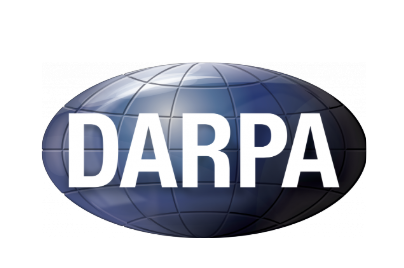Adsorption Coupled with Photo-induced Charge Transfer
Hu Lab Research Direction
Key Takeaway
Vision Statement

Our Work
By drawing on insights from surface adsorption and equilibria in heterogeneous catalysis, and considering their interplay with photo-physical phenomena such as charge separation and charge accumulation, we develop coating strategies that tune how reactants transport to and adsorb on photocatalyst surfaces.
Impact
Our innovations improve light-to-chemical conversion efficiency and selectivity, paving the way for room-temperature chemical production pathways with visible-to-infrared photon energy.
Moreover, it allows for synergic photo- and thermal-catalysis implemented at various scales and geographically dispersed locations.
Research Background
Our Research Question
Photocatalysis offers a promising approach for agile and on-demand chemical manufacturing under intensified processes.
However, its relatively low efficiency and activity compared to conventional (thermal-)chemical production systems has hindered its deployment. Many photocatalytic systems primarily rely on tuning band energetics and photogenerated charge carrier dynamics to drive the reaction.
As a result, the processes of light absorption, charge carrier photogeneration, separation, and transport have been the primary focus of designing photocatalyst design.
Until recently, we have started to address the long-standing overlooking of a fundamental principle: For any photocatalytic reaction to proceed effectively, the reactant needs to come in contact with the photocatalytic surface so that photo-induced charge transfer can proceed effectively.
Our Research Direction
Our work aims to advance photocatalyst design by modifying the photocatalytic surface to promote favorable chemical interactions. We achieve this by:
- Promoting Selective Adsorption/Desorption Processes
- Interfacial Passivation and Surface Functionalization
- Reaction Microenvironment Tuning
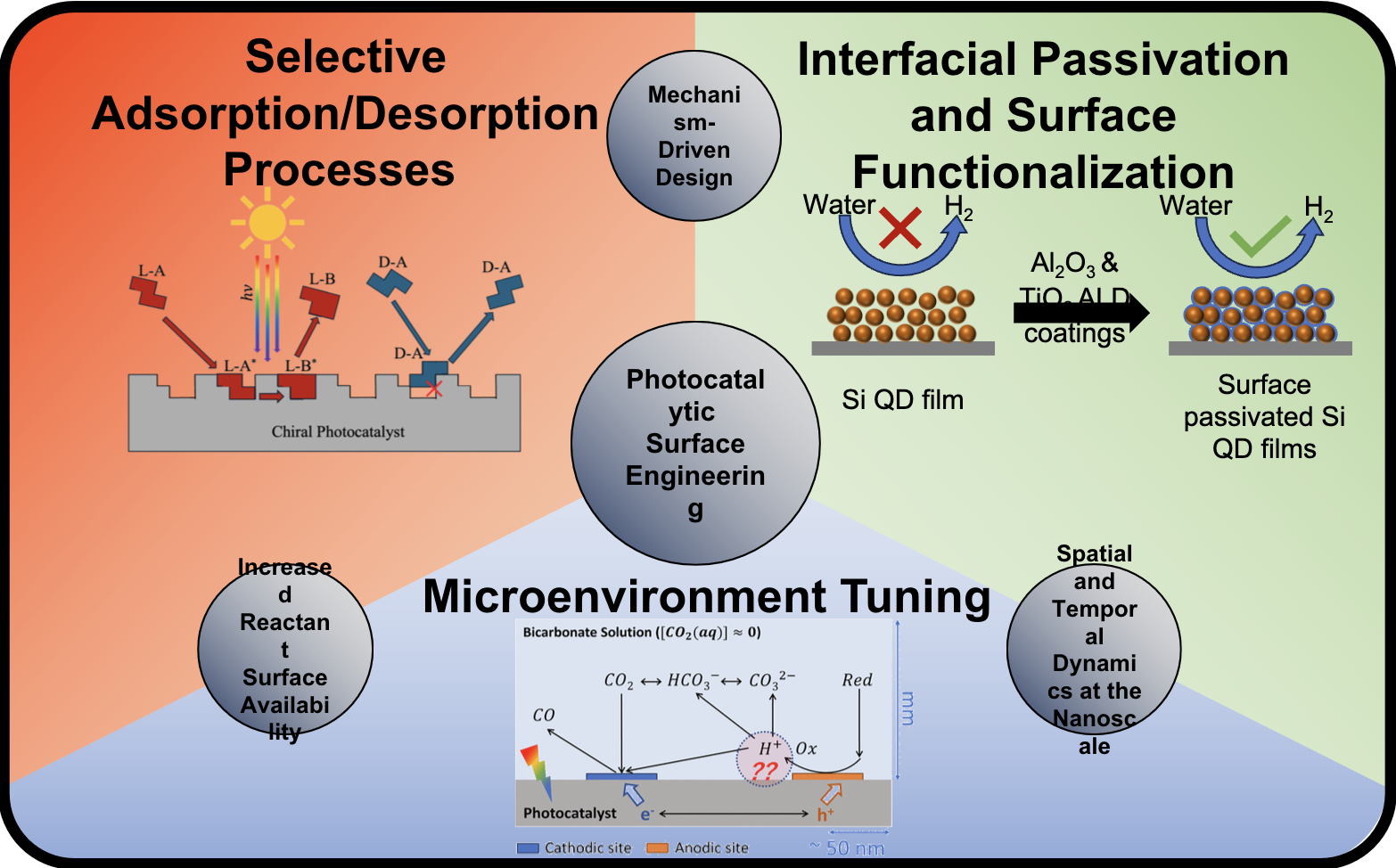
Our Research
Selective Adsorption/Desorption Processes
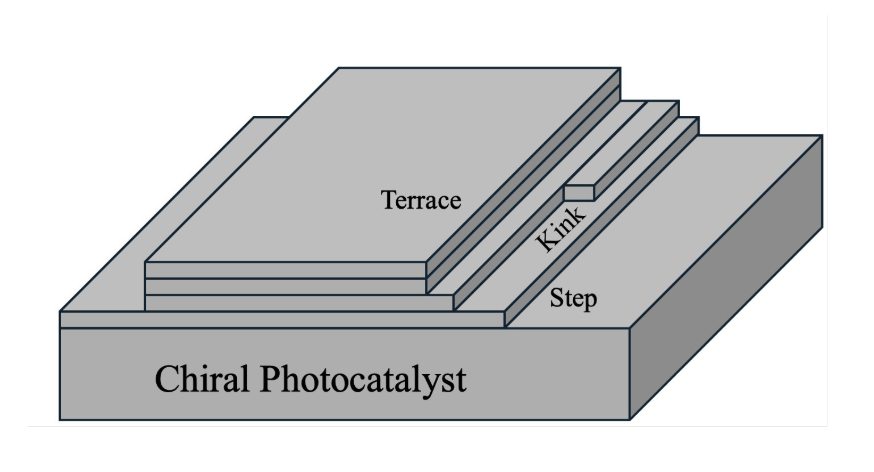

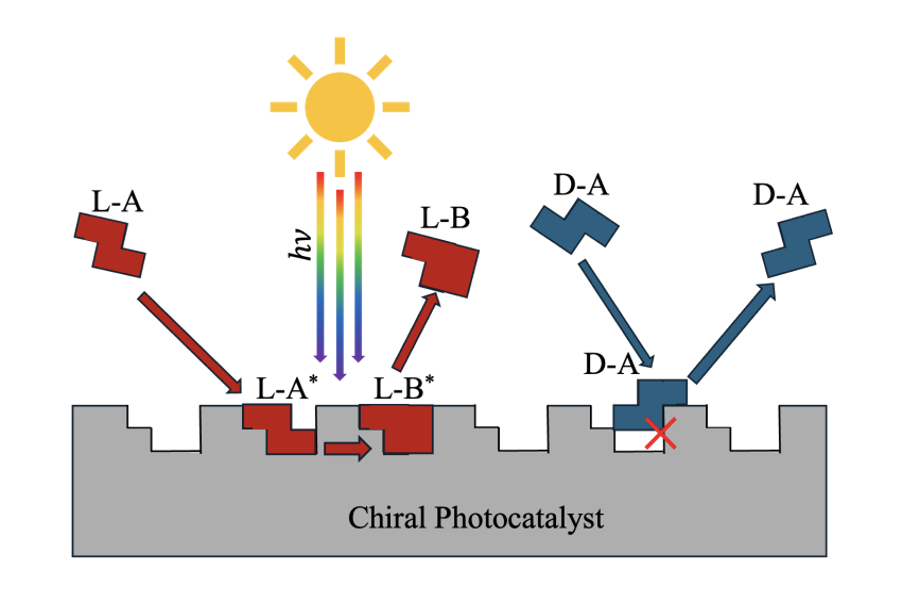
We engineer light-activated semiconductor surfaces through precise surface modifications to enable the selective adsorption and desorption of chemical species and intermediates on photocatalytic surfaces. These modifications can include techniques such as miscut polishing, controlled faceting, and thin-film coatings.
For example, we have developed chiral architectures that promotes selective charge carrier excitation. This surface enables “lock-and-key” molecular recognition and spin-polarized electron transfer to preferentially decompose one enantiomer, offering a powerful strategy for chiral resolution in applications ranging from drug synthesis to advanced material fabrication.
Passivating and Functionalizing Surfaces
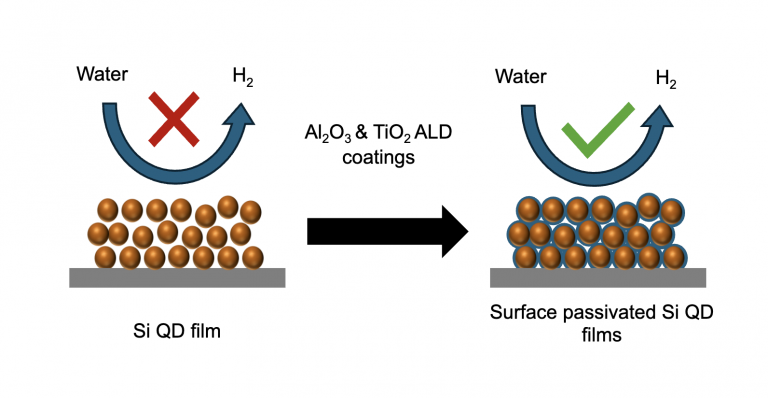
Although photocatalysis is primarily a charge-driven process, surface processes can still inhibit the reaction. We explore strategies that passivate and functionalize these surfaces, overcoming such challenges while persevering the photocatalyst’s opto-electronic properties. By fine-tuning these surfaces, we can design previously kinetically limiting photocatalysts to become viable.
This has been demonstrated in our work with silicon quantum dots (QDs), which are naturally inactive for photocatalytic water splitting due to the formation of Si-OH surface groups upon water adsorption, hindering the transport of photogenerated charge carriers at the surface. To address this, we employed TiO2 ALD coatings as a conductive protective layer, enabling the reaction. However, to mitigate the charge migration and enhance the activity of the Si QD, we incorporated ALD-grown Al2O3 layers into the coating.
Tuning of Reaction Microenvironments
The microenvironment plays a key role in determining the local chemical interactions, equilibria, kinetics at the photocatalytic surface. Nanoscale chemical transport, adsorption/desorption, and charge separation/accumulation are essential processes in photocatalysis. We co-work to optimize these processes by fine-tuning the local reaction environment, opening new pathways to make previously impractical photocatalytic systems viable.
This approach has been successfully applied to achieve photocatalytic CO2 capture and conversion without the need to purify or feed gaseous CO2. There, we examined how spatial and temporal in pH and local bicarbonates and CO2(aq) concentrations can influence light-driven CO2 reduction activity and selectivity.
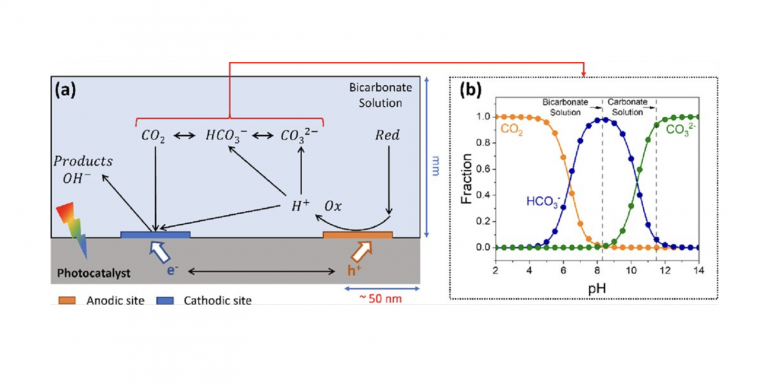
Future Work
We are expanding our framework to include more complex mechanisms, such as photothermal CO2 hydrogenation at ambient pressure. Since photothermal catalytic reactions depend on both adsorption/desorption dynamics and photo-induced charge transfer processes, our investigation will focus on the following strategies:
- Implementing alkaline regulation to tailor the microenvironment to enhance CO2 adsorption efficiency under low partial pressures.
- Modifying the catalytic surface to improve charge transfer from photo-thermally-induced active centers to the absorbed substrate.
- Investigating the interplay of light and heat energy in activating the metal–semiconductor interface to drive hydrogenation reactions.
To validate and advance our hypotheses, we will integrate high-throughput reaction parameter sweeps with product detection and in situ adsorption characterization techniques. This comprehensive approach is designed to deepen our understanding of photo-thermal reaction pathways and catalyst behavior, guiding the rational design of highly efficient photocatalysts.
Conclusion
For any reaction to proceed, the reactant must at some point interact with the surface. This fundamental principle has governed our research direction for designing high-selectivity photocatalytic systems, focusing on the multi-phase interactions between the semiconductor surface and reactants while still considering charge transfer dynamics.
High selectivity, a key advantage of photocatalysis, can be achieved by tailoring the surface interactions such as molecular adsorption/desorption. With our material fabrication and characterization capabilities, we can also manipulate these interactions by tuning the photocatalyst’s surface properties via thin-film coatings, or the reaction microenvironment.
The Hu Lab works to establish a fundamental understanding of the complex interplay between opto-electronic and catalytic processes in light-driven reactions. We have pioneered a comprehensive approach that goes beyond the traditional focus on photon absorption and charge carrier dynamics to address the challenge of co-optimizing photocatalytic selectivity, activity, and stability.
This design framework incorporates the crucial role of interactions between reactants, intermediates, products, and the photocatalytic surface, alongside various surface processes. We achieve this through a combination of materials characterization, experimental design, and modeling.
Our investigations explore how photocatalytic surfaces can be specifically tailored for a reaction and how these modifications influences the underlying reaction mechanisms and promote desired interactions, ultimately optimizing the performance of photocatalytic systems and opening new avenues for sustainable energy production and chemical synthesis.
Future work will involve expanding the range of reactions this approach is applicable to (e.g. photocatalytic chemical precursor production) and probing how surface modifications modify photogenerated charge carrier dynamics.
Acknowledgements & References
Acknowledgments
- NSF
- DARPA
References
- X. Zhen, R. Yanagi, Z. Pan, C. Zhou, T. Liu, B. Chen, K. Katayamai, S. Hu*, C. Chu*, “Photosynthesis of hydrogen peroxide from water and oxygen from a scaled-up 1-m2 reactor”, Chem Catalysis, 5, 1012238 (2025). DOI: 10.1016/j.checat.2024.101238
- R. Yanagi, T. Zhao, M. Cheng, B. Liu, H. Su, C. He, J. Heinlein, S. Mukhopadhyay, H. Tan, D. Solanki, and S. Hu, “Photocatalytic CO2 Reduction with Dissolved Carbonates and Near-Zero CO2(aq) by Employing Long-Range Proton Transport”, Journal of the American Chemical Society, 145, 28, 15381-15392 (2023). DOI: 10.1021/jacs.3c03281
- Atsu Kludze, S. Gulati, S. Hu*, “Opportunities for Heterogeneous Photocatalysis”, Catalysis Letters, in revision.
- Xiaohan Ma, Zhaohan Li, Quinn Ennis, Haoqing Su, Rito Yanagi, Yeonjoo Lee, Uwe Kortshagen, and Shu Hu*, “Enhanced Charge Separation in Coating-Protected Porous Silicon Quantum Dot Films during Photocatalytic Hydrogen Evolution”, Advanced Functional Materials, in revision.
